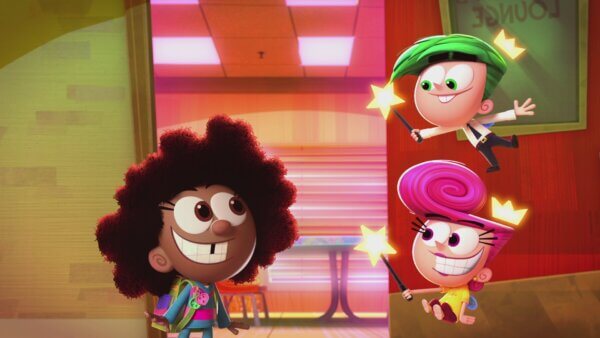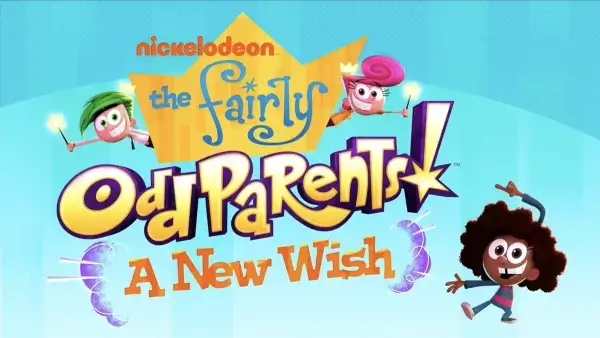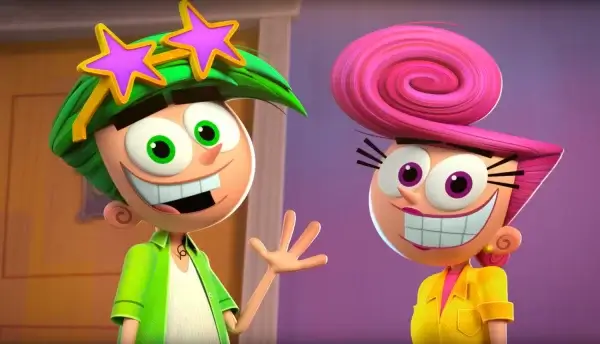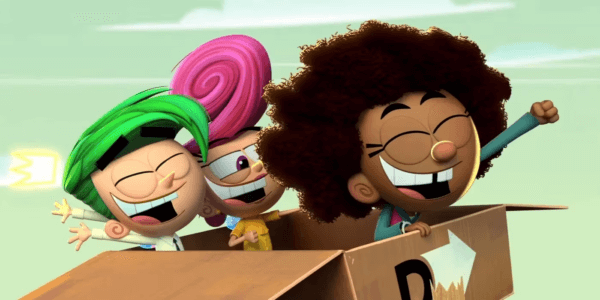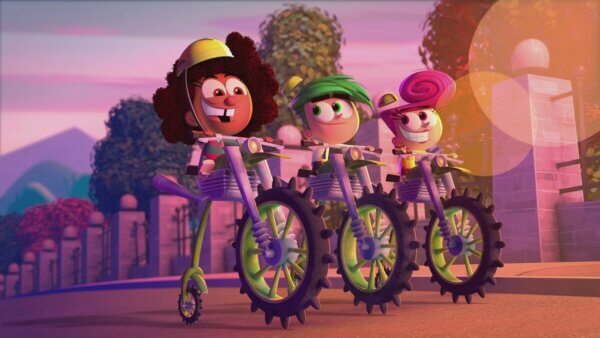Fairly OddParents: A New Wish | Interview with Co-Creator Ashleigh Crystal Hairston
It’s hard to imagine the comic pulse of children’s television without Butch Hartman’s The Fairly OddParents. Though its legacy often plays second fiddle to the omnipresence of SpongeBob SquarePants, the show’s wildly imaginative world and absurdist, joke-a-minute comedy made it an instant hit for Nickelodeon in the early 2000s and left a spirit that can still be felt in much of the network’s current output. However, a prolonged period of arrested development – including three reviled live-action television specials, Hartman’s unceremonious exit from Nickelodeon, and a failed animated/live-action hybrid reboot – fans weren’t sure where the series stood.
Then, in May, Fairly OddParents went back to basics with a fully animated reboot, subtitled A New Wish. This new take on the classic formula centered itself on a wholly new protagonist: Hazel Wells, a young Black girl whose family moves to the big city of Dimmadelphia after her father lands a new job. Already struggling to acclimate, Hazel’s life is further flipped upside down when she discovers her apartment neighbors, returning characters Cosmo and Wanda, are secretly fairies. Charmed by Hazel’s big heart and even bigger personality, the couple come out of retirement to be Hazel’s fairy godparents proper and, naturally, antics ensue.
The series premiered stateside earlier on Nickelodeon and, though its rating success has thus far been modest, critical and audience response has been very positive, convincing fans old and new that there is still life in this legacy property. Much of it comes from Ashleigh Crystal Hairston, a first-time showrunner who serves as A New Wish’s co-creator, co-writer, co-story editor, and star – Hairston, who is Black, voices Hazel and imbues her with many autobiographical elements. It would be a deep first dive for any creator in animation, let alone a name this fresh with a brand this recognizable, yet it is one Hairson has made with grace.
A New Wish brings Fairly OddParents back to its roots, imbuing valuable coming-of-age lessons with zany and colourful comedy, all anchored by a fresh, 2.5D animation style courtesy of Dublin-based studio Giant Animation. Hairston, alongside co-story editor Lindsay Katai (Infinity Train), have crafted a beautiful protagonist in Hazel, an unabashedly weird kid who is still caring enough to recognize areas where she can grow. In an era where children’s television can prioritize distraction or malaise, Hazel gives Nickelodeon’s programming some much needed nuance. UK viewers will be able to witness it for themselves when the series premieres on Netflix this fall.
We spoke with Hairston all about her experience working on A New Wish, the dance of experimenting with a beloved property, and the challenges that came from working on an animated series with a tight budget and a global audience. Here is our conversation, edited for length and clarity.
Ashleigh, you are in a unique position. You were asked to come aboard this reboot, The Fairly OddParents: A New Wish, after not having been a superfan of the original series, yet you’re still being asked to deliver a rebranding for one of the network’s most popular IPs that has an ardent fanbase. What were your initial instincts? Are you thinking, “It’s time to rewrite this,” or are you immediately feeling beheld to the source material?
I think it was beneficial to the show that its two story editors – myself and Lindsay Katai – had no ties to the original series. We both are a bit older and did not grow up with the show, but we had an admiration for it and its characters. We also had a background of adventure storytelling. With Lindsay coming off of Infinity Train and then myself coming off of Craig of the Creek, we both came in wanting to tell a great story with a great character. We went and binged the first 5 seasons to catch up and get a firm understanding of what this show was, and it was just joke after joke after joke after joke. That’s fine, but we wanted to get back to the heart of the series, which is what would happen if a kid got unlimited wishes. We knew that Nickelodeon wanted a new godkid, but they wanted to bring back Cosmo and Wanda. That was their initial request but, honestly, some of us were like, “What if we got new godparents?”
See, that’s what I’m curious about. Is there a part of you that really wants to start fresh, even when the network wants something from you?
We were open to the idea of new godparents, but I never want to make fans angry. While voice acting on Tiny Toons Looniversity, I saw all of the commotion when the creative team made Babs and Buster Bunny siblings as opposed to potential love interests. That was a really big choice on their part and the fans just couldn’t get past it. So, I personally was all of the mind of giving people what they want but also changing it to give them something new, fresh, and fun. We ended up bringing back Cosmo and Wanda, which we were very excited about, but with a new godkid in a new location. In a way, it was still starting from scratch, getting back to the heart of the storytelling, getting back to the heart of wish-making and doing it in our own way with our own comedic instincts. Lindsay and I both have a background in improv and sketch comedy. That’s another difference between us and the Butch Hartmans of the world and I think that helped a lot with creating a fresh, new series. I was a little concerned going in, I was like, “How is this going to be received?” It’s the same formula but it is very different, somehow.
Yes, it’s a very different show, in part because of your new lead, Hazel. The early Fairly OddParents episodes were certainly fueled by testosterone. It’s not insignificant that two women were asked to take a new approach to this series and decided to center it on a young girl. It radically shifts the perspective and dynamic of the series.
Absolutely. That’s the fun of it all. We both get to come into the show with our own personal experiences as women. Making her problems more internal as opposed to Timmy’s external problems really helps to change the wish-making and the storytelling. But also, we couldn’t get away with all of that prior humor. I wanted to be vile and aggressive and sarcastic. We would have loved to put more chainsaws in the series and blow people up, but we have to cater to a different audience. Kids are different now than they were in the early 2000s. The way kids watch cartoons, the way kids interact with their parents, and the way they grow up is different. The world is scary now and you don’t want to scare kids. You want it to be an enjoyable experience for them. Standards and Practices were on our tails; there were a lot of jokes that we could not get away with.
The days of The Animaniacs-esque censor-hopping are long over.
Oh my god, long over.
You mentioned this idea of how Hazel’s internal problems versus Timmy’s external problems changed the approach to the show. I’m curious if there were other things you picked up on while watching the original show that you were interested in messing with?
We wanted it to be a little bit slower-paced. We wanted it to be less loud, less screamy. We wanted Hazel to be a little girl and also be weird. Nickelodeon is such a boy-centric network. Even after taking the risk of making a little black girl the lead character, we also wanted to showcase that, yes, little girls can be weird, too. They can be a little offbeat in what they like and what they play with. She loves anime, she collects rocks. Lindsay and I, we’re both big weirdo kids. I remember in my interview for this job I was telling them the story of how I used to collect the reflector lights in the roads while I was a kid growing up in Seattle. I used to collect those off of the ground. [both laugh] I would keep them on my back porch on our deck and I would name them. Those were my pets. We called them turtles in Seattle, so I was like, “These are my pet turtles.” Our pilot episode begins with Hazel talking to her pet rocks; that came from me. We wanted to be able to show a little weirdo — except we can’t even say “weirdo” anymore. We had to call her “quirky.” I didn’t even mention the part about working with Netflix on this.
I was going to ask about that.
That was another learning curve. They have a global audience, so we had to be mindful of the entire world when approaching character and story. There was a time where they asked, “Well, can’t Hazel be more aspirational? She should be—” perfect, is what they were saying, because kids are going to want to be that. “She needs to be a little more put together. She needs to not be so out there.” We were like, “Well, in order for her to get fairy godparents, she has to be a bit miserable.” With Netflix, we had to pull back even more to show that even though she’s quirky and fun, she’s still someone that kids can relate to.
All kids are unhappy.
Yeah, it’s normal, and that’s okay.
I know that when you were approached for the series, they were intent on having the protagonist be someone of colour. Was it at all a dance to let more people of colour be at the center of the show?
It was not. We knew we wanted to make Fairy World more diverseas well. That was a conscious choice by Lindsay and I and [co-executive producers] Dave [Stone] and Daniel [Abramovici] supported it too. We saw initial drawings coming for some of our background fairy characters and there was no diversity. We were like, “This is not going to work for us.” If we’re going to do a new story and tell it from a new point of view, that world is going to look different. I think that’s something that you get when you have people of colour making decisions as part of the producing team. I remember saying, “Fairy World should look like walking into an Apple Store.”
That’s a great way of putting it.
When you walk into an Apple Store, you see all different kinds of people. We went back to the drawing board and they came back with all different kinds of body shapes and colours and hair textures and styles. They did an exceptional job of revamping our fairies and creating a new Fairy World. There wasn’t necessarily a push, but it it took someone to call it out and say, “This is what we want to show.”
Speaking of animation, what role did animation play in your artistic upbringing and what are some of your touchpoints?
That’s a great question. I grew up in the early 90s, which I like to consider the golden age of cartoons. I grew up watching Saturday morning cartoons like DuckTales, Looney Tunes, and then Nickelodeon favorites like Rugrats, Doug, Ren and Stimpy. I’ve seen every episode of Tiny Toons, of course, and Tom & Jerry was a big one, too. Every episode’s hijinks – “What are they chasing after? What’s going on?” – I feel like that is what informed my approach to cartoons. That was all formative, but I only watched them for entertainment’s sake. I never watched them thinking, “Someday, I want to go into animation,” or, “I want to be a voice actor.” That was never even a thought. I only started voice acting in 2018 and writing for animation in 2020. This is my first foray into animation as a creator and as a writer. I would consider myself still in the beginning phases of my animation career. There is an awareness of my influences, but I’m just pulling from what I know. I think that is maybe why [A New Wish] is such a different product. As I grow and get asked questions like these, I am having to think, “Oh yeah, I guess I was influenced by the Hanna-Barbera style, and that’s coming out in these new shows.”
When I think about Hanna-Barbera cartoons, I think of families like The Flintstones and The Jetsons. All of the comedy came from family and relationships. The original Fairly OddParents, while it has elements of their relationships, was more about the zaniness of it all. A New Wish feels like it has some of that family element as well.
There’s a reason why those shows went on for so long and those characters are so beloved and feel like real people. I think there’s something really beautiful there that captures the true essence of character and empathy and compassion. I think my theater and acting background has a little bit of an influence there. I like to focus on character and relationships. The dynamics surrounding that are important. I even have a lot of live action influences – The Cosby Show, Family Matters, Step by Step, Full House – those kinds of family stories. That is apparent in a lot of the stuff I’m doing now.
I want to transition to talking about the shift in animation style, specifically from hand-drawn 2D to CGI 2.5D. When you came onboard, did you already know that the show would be attempting this shift?
We always knew that it was going to be CG animation. When I joined, they showed me some test animation passes from different studios just to get a feel of what it was going to look like. Dave and Daniel were really at the helm of creating this new look for Fairly OddParents. They were really influenced by The Peanuts Movie. Lindsay and I had no understanding of CG — the approach, how much it costs, we didn’t know anything. Dave and Daniel were so kind. They were like, “All right. We’ll try to explain this to you.”
Did the new art style excite you? What were some of your initial thoughts learning that you were going to visually reinvent the show?
We were so excited. We knew it was going to look incredible and elevate the show in a really dynamic way. Then, when we got into it, that’s when we were like, “Why are we doing this? Who’s idea was this?” [laughs] We started to realize all of the challenges that come with making a show in CG. Number one, it’s extremely expensive, which means that we have to be very resourceful in how we design each character, prop, and environment. It was challenging for Lindsay and I, story-wise. During the animation prebuild, we had 40 characters, 150 props, and 20 sets to work with. That’s what we went into the show with. For each new episode, we got to make 4 new characters or 8 variants, 20 new props, and one set.
Single-location comedy takes on a whole new meaning. [laughs]
Exactly. We were like, “You’ve asked us to make a show about unlimited wishes with very limited assets.” However, Dave and Daniel were really good at expanding our world just by using different angles, different shots, and reusing things. Another challenge came when we started getting into the design for Hazel. We wanted her to have natural hair and there was a learning curve in approaching how to do natural hair in CG. I was sending our animators pictures of my hair as examples. I was sending them a texture chart for how textures work for Black hair. I would say that she falls somewhere in a 4B, 4C range for curls. Working collaboratively to accomplish a lot of different things in CG was a challenge but also really fun. I think we created a much more interesting and dynamic mixture between 2D and CG, which was also a conscious choice.
Now that you’ve had some time away from working on the series, what are some of the takeaways that you gained from the experience?
I learned so much. The whole process has been a whirlwind. We started development in January of 2022 and finished in March of 2022. The writers’ room started March 2022 and completed the scripts in May 2023. That’s fast.
That’s crazy.
This was my first-time co-executive producing, co-story editing, and being the voice of the world. I did a lot and I couldn’t have done it alone. Dave, Daniel, Lindsay, and I were a four-headed beast working in tandem. Thankfully, Fairly OddParents is also such an easy show to make. Butch Hartman and Fred Seibert [the original show’s executive producers] laid out fantastic groundwork for us and made a beautiful playground for us to play in. I’m really proud of myself, especially for it to be my first time, too. It’s kind of wild. Now that the show has been out, I’ve been on Twitter and have been seeing such a positive reaction. People are like, “Fairly OddParents is actually good again? What?” To see everyone actually enjoying it and saying that it feels like a new, fresh take on the series feels really, really good. I’m very pleased and very happy and very excited for everyone to see the rest of the series, because it gets even better.
Fairly OddParents: A New Wish will premiere on Netflix in the UK this fall at a date yet to be announced.


